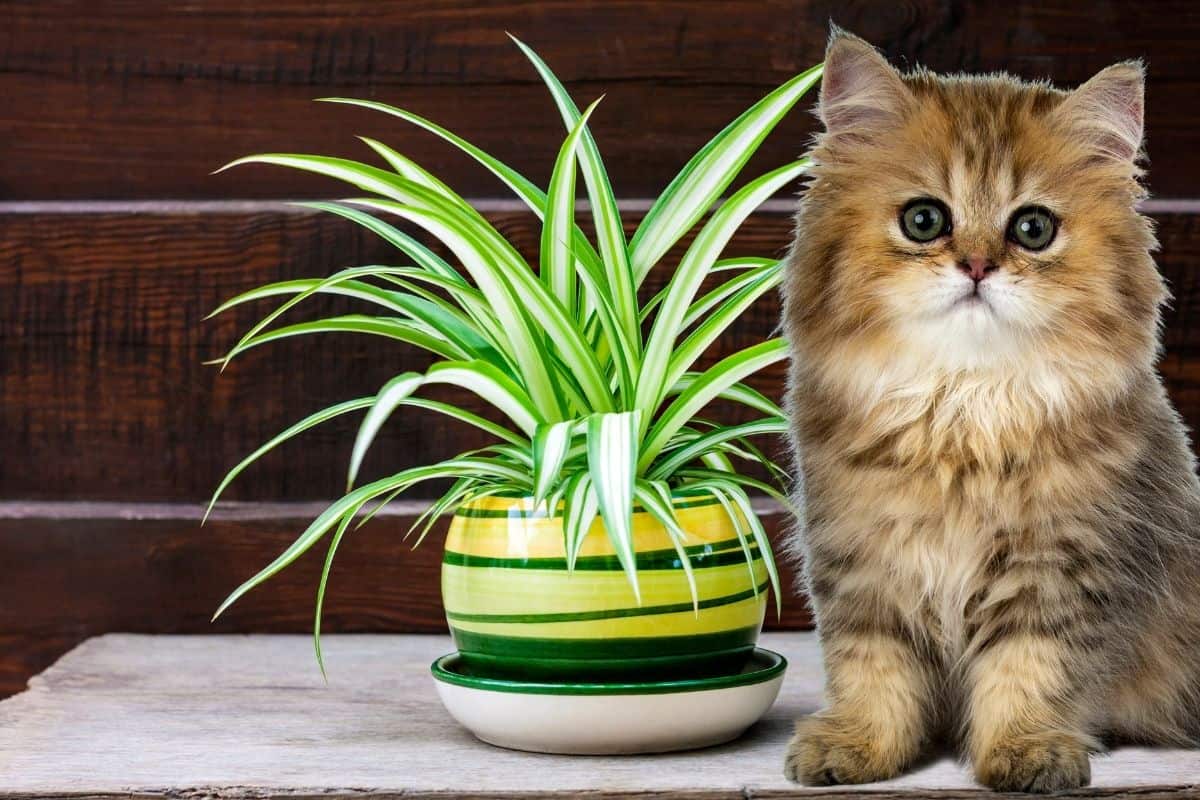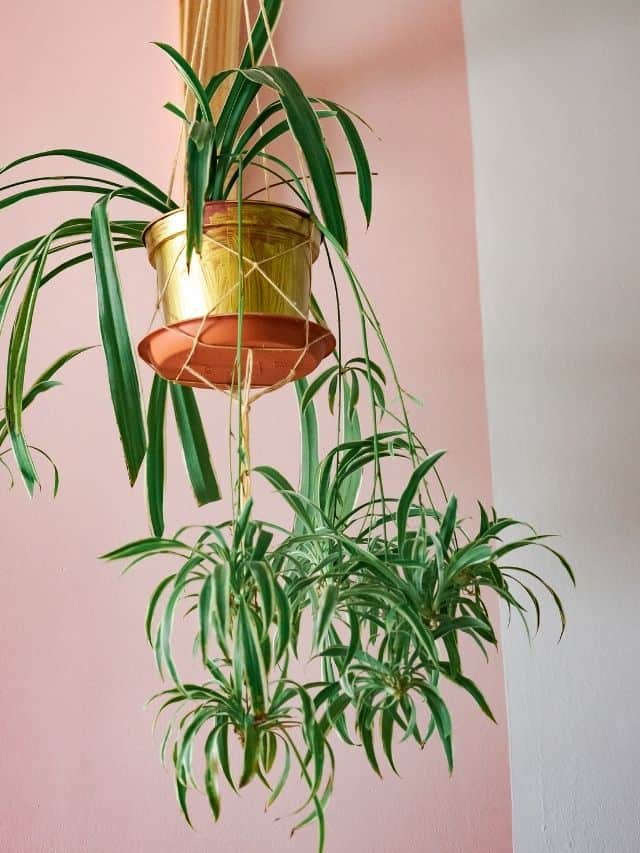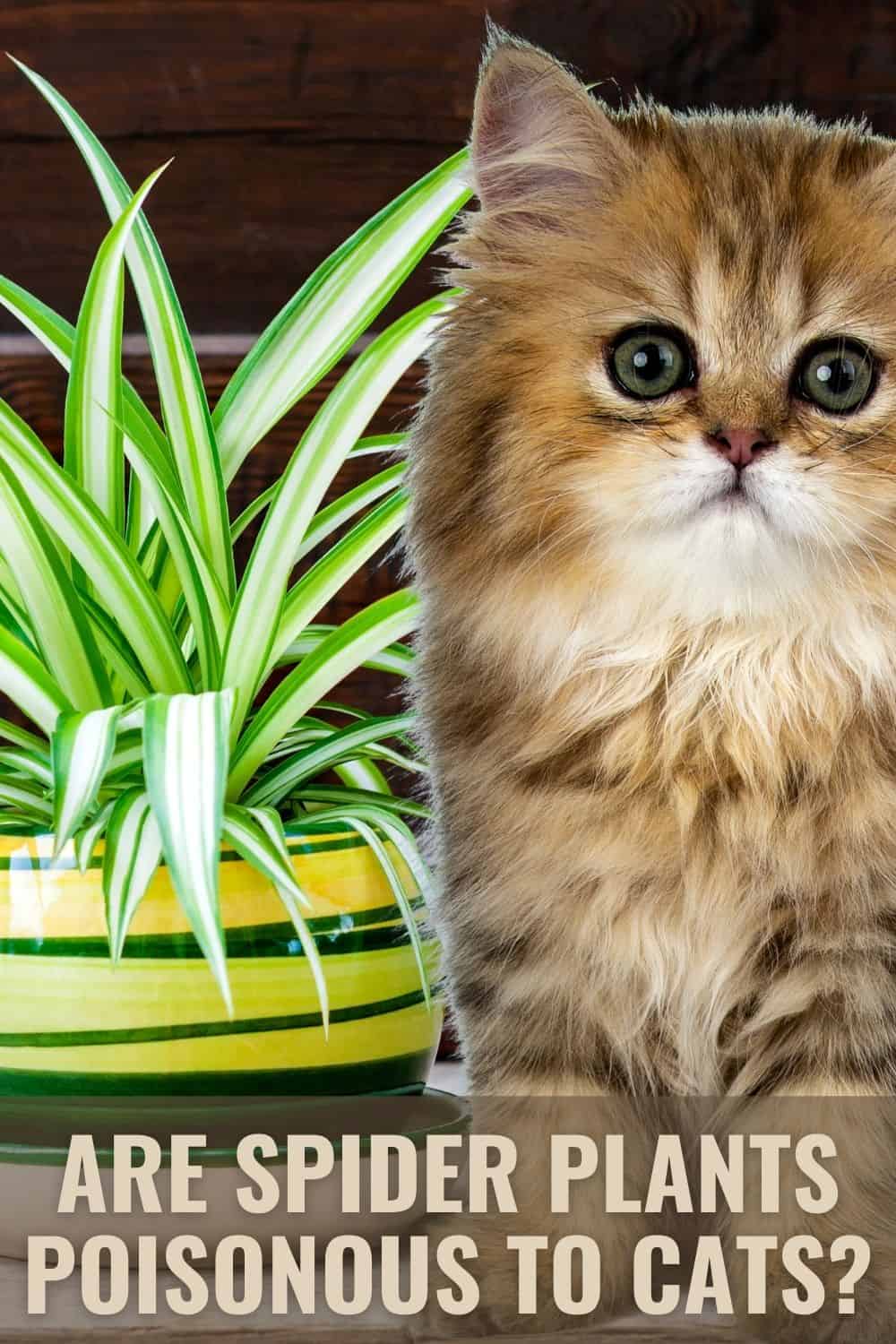Are spider plants poisonous to cats? If you are a pet parent, you have an obligation to your pet to make sure they do not come into contact with any toxic plant that can harm them. The problem is, many popular houseplants can be dangerous for your furry friends. Let’s take a look at any potential dangers from the spider plant.
Also referred to as spider ivy and ribbon plant, this is one of the most ubiquitous indoor plants due to its hardy nature. They’re great for new houseplant hobbyists, or even people who don’t have much of a green thumb. However, it is no match for a persistent cat with a penchant for being spaced out, and your new spider plant could be demolished within days of bringing it home.
Spider plants are not poisonous to cats. However, they are often irresistible because they are mildly hallucinogenic, and their leaves are relatively grassy. This grassy texture really draws kitties in to play with it. Spider plant leaves contain chemicals similar to opium, so in addition to giving your feline a high, they may cause diarrhea, vomiting, or an upset stomach if it eats too much of it, which cats tend to do. In general, it’s probably best to avoid letting your cat eat it and opt for safer alternatives.

Let’s explore this in more detail.
Understanding and Identifying this Plant

Although this plant is not toxic to cats, it can be tricky because there are other plants that are sometimes called the same name and some of them might be toxic. This is why it is essential you know how to accurately identify the plants you bring into your home. Let’s get clear on what plant we’re talking about by using the scientific name.
The spider plant’s scientific name is Chlorophytum comosum. The slender arching leaves sometimes edged with white, can grow up to one and a half feet long. The plant reproduces by putting out trailing vines on which the babies grow while still attached to the mother plant.
Variegated forms of this plant are the most popular and it does well in indirect light, but some sunlight is needed to keep the variegations forming. Without enough light, the variegated plant will turn all green.
Facts about spider plants
Apart from being the most cultivated house plant around the globe, these plants are valued for their air-purifying abilities. A study by NASA found that they are one the best plants for removing pollutants like formaldehyde, ammonia, benzene, trichloroethylene, and other solvent fumes.
They increase indoor humidity while adding a bold splash of green and white stripes to a room, which is aesthetically pleasing. They need bright light and infrequent watering.
They can be grown in hanging baskets, pots, or the garden and make an attractive display on tables, windowsills, or hanging from the ceiling.
These plants have also been shown to reduce stress levels, tension, anxiety, and depression and improve mood. Allergy sufferers may find them a boon because they remove allergens from the air.
Where are they from?
Where do these fun, beautiful plants originate? They are from South Africa, where they are widespread in the Western and Eastern Cape provinces, KwaZulu- Natal, Mpumalanga, and Limpopo.
The plant has been used medicinally by the Nguni people for pregnant mothers. The roots are dipped into a bowl of water that the mother drinks every day, which is believed to protect her baby.
These plants are also native to tropical Africa and have become naturalized in other world regions due to their popularity. They are now one of the most common houseplants in the United States.
What are their benefits?
Not all ribbon plants have green and white leaves – some are just solid green. They are drought-resistant and relatively immune to pests and diseases. In hot, dry climates, this plant prefers partial shade, and they are not particularly frost-tolerant.
They are also suitable for preventing erosion on steep embankments.
There are a few different cultivars of this plant that are popular as houseplants. Chlorophytum comosum variegatum has green leaves with white margins, while Chlorophytum comosum vittatum has white striped leaves with green borders.
A more recent cultivar is Chlorophytum comosum Mboyeti which has green leaves with wavy edges and a lighter green midrib.
All spider plants are easily propagated by transferring the plantlets on the long inflorescences of the mother into their own pots. They can also be grown from seed.
Why Do Cats Eat Plants?
Everyone knows that cats are carnivores and can’t survive on a vegetarian diet, so why do they eat plants? A cat’s digestive system can’t break down grass and other plants, and they just bring up most of it in a foamy undigested state. Vets say that cats may eat grass and other plants for various reasons.
Grass contains folate, a natural form of vitamin B9 that pregnant women take in the form of folic acid to prevent severe congenital disabilities. Your cat may just be feeling the need for some vitamins. Grass may also help with gastrointestinal problems or stomach discomfort and stimulate bowel movement.
If your cat regularly kills and eats wild birds or rodents, feathers or fur may get into its stomach and not be that easy to pass. Plants could help by inducing vomiting to get rid of indigestible components in your cat’s stomach.
Some have said that plants may also soothe a sore throat or that cats just like their taste and texture.
A few years ago, researchers decided to conduct a study on why cats eat greenery. They discovered that cats don’t only eat plants when they are feeling unwell.
Eating plants is actually a prevalent behavior in cats, and they don’t always vomit the plant up after consuming it. The researchers surveyed over one thousand cat owners who spent a minimum of three hours a day observing their felines. Seventy-one percent of cats were reported to have been caught eating plants.
The vast majority of owners said the cats did not look sick before consuming the greenery. The researchers theorized that eating grass helps to expel intestinal parasites. While this may explain why cats and houseplants can be a dangerous mix in some cases, it does not bode well for your spider plant with its long grassy leaves!
Here are more plants that are not dangerous for cats.
Why your cat may love this plant
Now that you know a bit about why cats in general like plants, let’s talk briefly about what is so enticing about this specific plant.
The leaves grow like ribbons, make it very springy and it blows around in even just a slight breeze. The air produced from a person walking by the plant or from heat or AC or a fan coming on can move the leaves around in such a way that your feline friend thinks it’s a cat toy!
When hanging in a basket, the baby shoots that come down from this plant are also very enticing to a cat. Everything about the way this one is built will make cats want to bat at it or pounce on it. And while it’s not on the list of dangerous plants, you still don’t want your cat to destroy it.
Keeping Cats and Ribbon Plants
So now that you know your cat poses more of a danger to your spider plant than the spider plant will ever pose to the cat do you abandon your spider plant?
The good news is you don’t have to do away with your spider plant if you put it in a hanging basket out of the cat’s reach. These plants are particularly well suited to hanging baskets as their long inflorescences with the babies growing on them trail down over the sides of the container.
Other things you can try to keep your cat away from the plant include sprinkling the leaves and surrounding soil with cayenne pepper or spraying them with diluted lime, lemon, or orange juice. Most cats hate citrus. You can also place the rinds of citrus fruits around the base of the plant on top of the soil.
Keeping your plant somewhere inaccessible to a bored cat is also recommended where possible. Grow some pet grass in a small planter for your cat to nibble on to distract him from your plants and play with him often so that he is too tired to get up to mischief.
You can also put your spider plant in a terrarium or even a domed birdcage. Make sure your cat’s litter box is cleaned regularly to reduce the temptation to dig and do his business in the soil of your potted plants, too.
Some people say cats and houseplants don’t mix, but with some education and the right precautions, it’s absolutely possible.
Keeping your cat safe from plants
The American Society for the Prevention of Cruelty to Animals (ASPCA) has a list of plants that are safe for cats as well as a list of dangerous plants for your pets. You may even want to print out a list of pet-safe plants to make sure you can enjoy your plants while also keeping your kitties safe.
While spider plant toxicity is not something you have to worry about too much, you still don’t want your cat to eat the plants you love and put work into. You can keep your beloved houseplant safe and your cat safe as well with just a bit of research and knowledge.
Even non-toxic plants are not great for your cats to eat because they can give them an upset stomach. Instead, you might get your plant-loving cat some cat grass they can enjoy and this will also help deter them from your houseplants.
Are Spider Plants Poisonous To Cats? – Conclusion
As we have explained, these beautiful plants are not toxic to cats, but you still don’t want them munching on the plant. Instead, you can get some cat grass for your cat to enjoy safely. It’s easy to grow and you can even purchase cat grass kits at common pet stores or online. Keeping dangerous plants away from your cat and other pets is very important.
Keeping your plant in a hanging basket or other places the cat can’t reach is the best way to keep it safe, but be sure it’s high enough your cat cannot jump off furniture and get to it. Since the benefits of having them are considerable, and they are not toxic to cats, they are one of the safest indoor plants for cat lovers.
Do you like spider plants? Did you learn anything new about cats and plants from this post?





Are Bamboo Plants Poisonous To Cats?
Sunday 20th of March 2022
[…] Related: Are spider plants poisonous to cats? […]